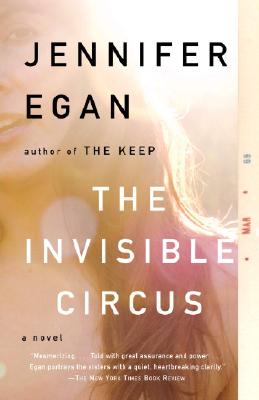Our book choice for March 2014 is The Invisible Circus by Jennifer Egan. In Jennifer Egan’s highly acclaimed first novel, set in 1978, the political drama and familial tensions of the 1960s form a backdrop for the world of Phoebe O’Connor, age eighteen.
The year is 1978. Phoebe O’Connor is an eighteen-year-old girl who is obsessed with the memory of her older sister, Faith, who died in Italy in 1970. Faith was a beautiful, idealistic hippie who was part of the counterculture movement of the 1960s. She was also a troubled young woman, and her death was ruled a suicide.
Phoebe is determined to find out what really happened to Faith. She retraces her sister’s steps from San Francisco across Europe, a quest which yields both complex and disturbing revelations about family, love, and Faith’s lost generation.
Along the way, Phoebe meets a cast of characters who help her to piece together the puzzle of Faith’s life and death. There is her childhood friend, Vladek, who is now a radical activist; her sister’s lover, Marco, a charismatic Italian artist; and her mother, Laura, a former political radical who is now trying to rebuild her life.
As Phoebe gets closer to the truth, she begins to realize that Faith’s death was not as simple as it seemed. There are dark secrets that her sister kept hidden, and Phoebe must confront them in order to find peace.
The Invisible Circus is a powerful and moving novel about loss, grief, and the power of love. It is a story about the 1960s counterculture movement, and the legacy of that movement for the generation that came after. It is also a story about family, and the bonds that can never be broken.
The Invisible Circus is a powerful and moving novel that explores the themes of family, love, loss, and the search for identity. It is a story about the power of memory and the importance of finding closure. The novel is also notable for its innovative use of narrative structure. Egan tells the story from multiple perspectives, using flashbacks, flashforwards, and dream sequences to create a rich and textured narrative.
The novel has been praised by critics for its complex and suspenseful plot, its well-developed characters, and its innovative use of narrative structure. It has also been a commercial success, selling over a million copies worldwide.
Discussion Questions for The Invisible Circus
- Do the 60s have enduring symbolism for America? How do we understand and misunderstand this era in our history?
- Are you able to characterize your generation? What traits would you ascribe to it?
- Describe the moment in which Phoebe first understands her sister’s suicide. What finally allows her to see the truth?
- Talk about the most important rite of passage you experienced. Compare the feelings and beliefs you held before with those you held after.
- When Phoebe meets Wolf — the man who accompanied Faith in Europe — how does her journey change? What does Wolf show Phoebe about herself?
- The Invisible Circus traces a younger sister’s search for her older sister. In what ways might the novel differ if the author had chosen to make the characters brothers?
- Does the title of the book deepen your understanding of the plot? How does the circus in chapter one reflect Phoebe’s experience?
- What role do images — paintings, photographs, postcards, and so on play in the novel? Is there a religious dimension to some of them?
- To whom would you recommend the book and why?
Individual Ratings
DKB's Rating 




Sue's Rating 




Miranda's Rating 




Catherine's Rating 




Baljit's Rating 




John's Rating 





